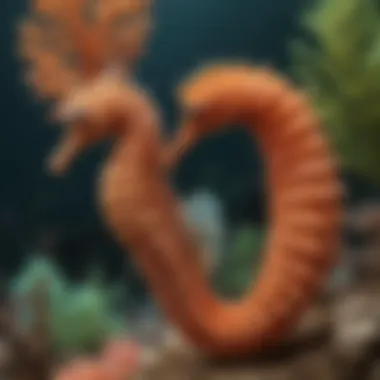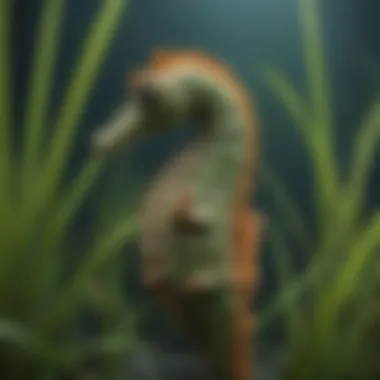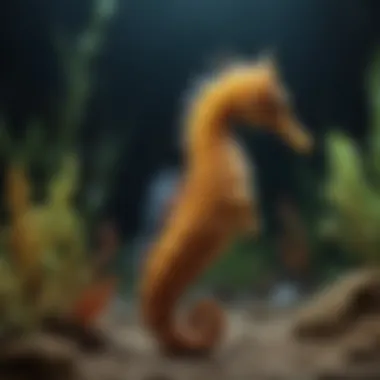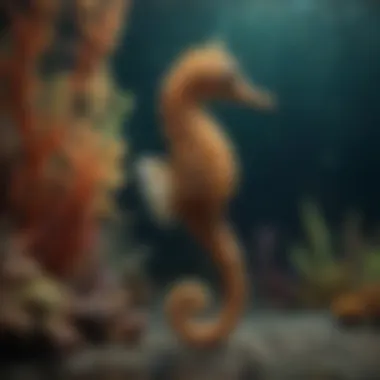Exploring the Mystical Realm of Seahorses


Nature Topic Overview
Seahorses are part of a unique family of marine life. These creatures are not just notable for their appearance. Their shape, behavior, and reproductive methods set them apart. Seahorses live in shallow waters, often found in mangroves, seagrass beds, and coral reefs. The waters of the Indo-Pacific region are popular havens for many seahorse species.
What makes seahorses remarkable is their upright swimming posture. Unlike most fish, they swim vertically. Many people may not know that male seahorses bear the young. The female deposits eggs into a special pouch on the male, where he fertilizes and carries the eggs until they hatch. This unique reproductive strategy is quite rare in the animal kingdom.
Apart from their striking behavior, seahorses also play important roles in their ecosystems. They contribute to the marine food web and inhabit ecological niches that help balance their environments. However, their intricate beauty hides a sobering truth: seahorses face significant threats due to habitat loss, pollution, and climate change.
As we explore the world of seahorses, we will uncover diverse species, their habitats, and the pressing issues they face. Understanding these aspects is not only fascinating but crucial for their survival.
Fun Facts and Trivia
Seahorses have some surprising features that can captivate young minds. Here are a few interesting facts:
- There are over 70 species of seahorses.
- Seahorses are known to change color to blend into their surroundings.
- They can be as small as 1.5 centimeters or as large as 35 centimeters.
Young readers might find the following facts engaging:
- Seahorses can hold onto objects with their tails, just like monkeys do.
- Some species make sounds to communicate.
Visual impacts like videos or images can enhance learning about these marine wonders. Showing seahorses in their habitats can be especially educational.
Wildlife Explorations
Seahorses belong to the family Syngnathidae, which also includes pipefish. Here’s a brief overview of some species:
- Hippocampus reidi: Known as the Longsnout Seahorse, this species is found mostly in Western Atlantic.
- Hippocampus zosterae: The Pygmy Seahorse is tiny, often smaller than a pea.
Their habitats range from coral reefs to sea grass beds. Living alongside them are numerous creatures:
- Starfish and sea urchins, which share the ocean floor.
- Tiny crustaceans, a crucial food source for these delicate fish.
Interactive features like quizzes can help children learn about their habitats through fun activities.
Environmental Awareness
Conservation is vital for seahorse survival. Programs are underway to protect their habitats. It is essential to create awareness among younger generations. Simple actions can lead to significant change:
- Reducing plastic usage to keep oceans clean.
- Supporting marine protected areas.
Teaching kids about these topics can inspire them to take action for seahorse conservation.
DIY Nature Activities
To further engage young minds, hands-on activities can deepen understanding:
- Crafting Seahorse Models: Children can create paper or clay seahorses, enhancing their creativity.
- Nature Walks: Exploring local habitats like ponds can help them connect with nature.
Encouraging kids to observe local wildlife fosters appreciation and respect for marine life.
Understanding and protecting seahorses is crucial. They represent not just a beautiful part of our oceans but also a symbol of marine health.
Through exploration and awareness, we can help ensure seahorses continue to thrive in our oceans.
Prolusion to Seahorses
Seahorses are a unique group of marine creatures that captivate people of all ages. Understanding these animals enriches our comprehension of marine life and its importance. Seahorses stand out not only because of their distinctive appearance but also because of their intriguing behaviors and ecological roles. This section offers an insight into their physical features and cultural significance, highlighting the delicate balance they share with their ecosystems.
Overview of Seahorse Characteristics
Seahorses are notable for their unusual body shapes. They have elongated bodies, a long snout, and a curled tail. Their armor-like skin is covered with bony plates rather than scales, adding to their peculiar appearance. Colors vary widely among species, often shifting to blend with their surroundings. This ability to change color is vital for camouflage and communication.
They swim differently compared to other fish. Instead of using their pectoral fins to propel themselves, seahorses rely on a small dorsal fin on their back, which they flap rapidly to move through the water. Additionally, their tails can grasp onto seagrass or coral, providing stability in strong currents and helping them perch.
Seahorses also have an interesting way of feeding. They lack teeth and stomachs; instead, they suck in tiny food through their elongated snouts. Their diet mainly consists of small crustaceans like shrimp and tiny zooplankton. This feeding method requires the seahorse to be patient and stealthy, often blending into the environment while hunting.
Historical Significance in Culture


Seahorses have held a significant place in various cultures throughout history. In ancient times, they were often associated with myths and legends. For instance, in Greek mythology, seahorses were believed to be the steeds of Poseidon, the god of the sea. This connection elevated their status and contributed to their allure.
In Asia, seahorses are utilized in traditional medicine, where they are thought to provide health benefits. They are often seen as symbols of patience and contentment. Many cultures view them as lucky charms, further emphasizing their importance in folklore and art.
Seahorses are not just marine organisms; they are symbols of mystery and intrigue, bridging the gap between ecological importance and cultural significance.
As we gain a deeper understanding of seahorses and their role in the marine ecosystem, it becomes crucial to appreciate and protect them. Their unique characteristics and diverse cultural significance underline the value of seahorses, encouraging conservation efforts.
Physical Features
The physical features of seahorses are not just fascinating; they play a significant role in their survival and behavior. Understanding these features provides insights into how these unique creatures navigate their underwater world. Seahorses possess distinctive body structures and colors that help them thrive in their habitats and avoid predators.
Anatomy and Form
Seahorses exhibit a remarkable anatomy that sets them apart from most other fish. Their bodies are elongated and have a horse-like head, hence the name 'seahorse'. A typical seahorse has a bony structure instead of the usual soft, fleshy body found in many fish. This bony armor serves as protection against predators.
Additionally, seahorses have a prehensile tail, which allows them to grasp onto seaweed, coral, or other substrates. This adaptation prevents them from being swept away by currents, an essential characteristic for their survival. A seahorse's dorsal fin, located on its back, is used for swimming. Though their swimming ability is somewhat limited by their small size, this fin helps them move vertically in the water, aiding them in getting food and avoiding danger.
Color Variations and Their Purpose
Color in seahorses is not merely for aesthetics; it has important functions. They can change their color to blend into their surroundings. This ability helps in camouflage, making it harder for predators to spot them. The color change can be influenced by several factors, including environment, mood, and even temperature.
Seahorses can be found in hues ranging from bright yellows to deep blues. Some species may have patterns that resemble the textures of the coral or seaweed they inhabit. This mimicry is crucial because it not only protects them but also assists in hunting, allowing them to ambush unsuspecting prey.
Moreover, color variations can play a role in communication. Seahorses may exhibit brighter colors during courtship and mating, signaling their readiness to mate. Understanding these nuances of color can provide deeper insights into their ecology and social behavior.
"The unique anatomy of seahorses, along with their ability to change color, highlights the adaptability of these extraordinary creatures in their aquatic environment."
In summary, the physical features of seahorses are not just striking; they are critical for their survival. From their bony structure to their color-changing capabilities, each aspect is an adaptation that reflects their ecological niche. Understanding these features enriches our appreciation of these remarkable marine animals.
Habitat and Distribution
Understanding the habitat and distribution of seahorses is vital to appreciating their existence. These areas are where they find food, shelter, and mates. Seahorses rely heavily on their environments for survival. Without suitable habitats, their populations can decline.
Global Range of Seahorses
Seahorses are found in warm waters across the globe. They inhabit various seas, from the tropical regions of the Indian Ocean to the temperate zones of the Atlantic. The most diverse populations can be found near coral reefs. These are vibrant ecosystems that provide ample food and protection.
- In the Indo-Pacific region, common species include the Eastern Pacific seahorse and the common seahorse.
- The Atlantic Ocean is home to species like the lined seahorse.
The distribution of seahorses can be influenced by water temperature and salinity. They prefer shallow waters, usually not deeper than 30 meters. This allows easy access to the sunlight that helps plants grow, creating a healthy ecosystem.
Preferred Habitats: Coral Reefs to Mangroves
Seahorses do not just settle anywhere; they have specific habitats where they thrive. Coral reefs and mangrove forests are prime examples.
- Coral Reefs: These ecosystems are rich in diversity, providing various hiding places. Seahorses often cling to corals, using their tails to secure themselves. This gives them protection from predators while allowing them to hunt for tiny shrimp and small fish.
- Mangroves: These coastal areas are very important for many marine species. The tangled roots of mangrove trees create nurseries for many fish, including seahorses. The still waters around mangroves provide a safe space for young seahorses to grow without immediate threats from larger predators.
Seahorses are often found in habitats rich in structure, which helps support their unique feeding and mating habits.
Ultimately, the habitats of seahorses are not just locations; they are ecosystems that support life on multiple levels. By safeguarding these areas, we can ensure the survival of seahorses and maintain biodiversity.
Behavior and Interaction
Understanding behavior and interaction is crucial when exploring the world of seahorses. These creatures exhibit distinct behaviors that play an essential role in their survival and reproduction. These interactions not only influence their individual fitness but also contribute to the dynamics of their ecosystems. Seahorses display fascinating feeding habits and intricate mating rituals, both of which highlight their adaptations to marine life.
Feeding Habits and Diet
Types of Prey
Seahorses primarily feed on small crustaceans, such as brine shrimp and copepods. Their choice of prey is significant, as these organisms are abundant in their natural habitats. This abundance makes them a reliable food source, aligning well with the seahorse's feeding habits. Copepods, in particular, are tiny and nutritious, making them beneficial for the energy needs of seahorses, which require a high intake of food due to their unique metabolic processes.
A key characteristic of crustaceans is their mobility. Seahorses are known for their slow movements, which means they must rely on the availability of stationary prey. The structure of their mouths is adapted to suck in prey, allowing them to consume food rapidly without much movement.
Advantages:
- High nutritional value of prey
- Abundance in various habitats
Disadvantages:


- Limited to areas where prey is available
Hunting Techniques
Hunting techniques of seahorses are unique because they do not actively chase down their prey. Instead, they are sit-and-wait predators. They use their camouflage to blend into their surroundings and wait for prey to come close. This method minimizes energy expenditure, which is critical for their survival.
The primary technique involves using their elongated snouts to suck in prey as it passes by. Seahorses can also adjust their body position to be more effective at capturing food. This hunting method showcases a practical adaptation, enabling seahorses to thrive in environments where quick movements would be ineffective.
Advantages:
- Energy-efficient hunting style
- Effective use of camouflage
Disadvantages:
- Dependence on the proximity of prey
Mating Rituals and Parenting
Unique Reproductive Strategies
Seahorses are known for their distinctive reproductive strategies, which set them apart from most other fish. One notable feature is the role reversal in mating. In many species, males undergo a form of pregnancy, carrying eggs in their brood pouches until they are ready to hatch. This unique approach not only ensures higher survival rates of offspring but also allows for greater egg output from females.
These strategies demonstrate that seahorses have adapted their reproduction to maximize their chances of survival in their environments. Their unique reproductive behavior can also result in increased genetic diversity within populations.
Advantages:
- Increased offspring survival
- Greater genetic diversity
Disadvantages:
- High energy cost for males during pregnancy
Role of Male Seahorses
The role of male seahorses in reproduction is a fascinating aspect of their behavior. As the primary caregivers, male seahorses carry the fertilized eggs in their brood pouches. After a gestation period, which can last from ten days to six weeks depending on the species, males give birth to fully formed juvenile seahorses.
This unique role allows females to focus on producing more eggs while males ensure the protection and nurturing of the developing young. This dynamic has promoted a unique bond between mated pairs, often leading to synchronization in their reproductive cycles.
Advantages:
- Shared parental investment
- Structured mating pairs increase reproduction success
Disadvantages:
- Vulnerability during pregnancy due to increased energy demands
Species Diversity
Understanding seahorse species diversity is crucial to grasp the complexities of marine ecosystems and the role these unique creatures play within them. There are over 70 recognized species of seahorses, each exhibiting distinctive features and adaptations. This diversity is vital as it contributes to the resilience of marine biodiversity. A varied genetic pool allows the species to survive environmental changes and threats, which is especially important in the face of climate change and habitat destruction.
Classification of Seahorse Species
Common Species Overview
Common seahorse species, such as the Hippocampus kuda and Hippocampus comes, are often found in coastal waters and are specifically adapted to thrive in shallow environments. These species are popular in both aquariums and research settings due to their relative abundance and ease of care. They typically exhibit a unique characteristic: their ability to change color to blend into their surroundings.
This ability not only provides camouflage from predators but also aids in social interactions during mating. Their popularity arises from their fascinating behavior, making them a beneficial choice for capturing the interest of audiences, especially for educational purposes. However, their presence in aquariums also leads to challenges regarding their care and conservation needs.
Endangered Species
On the other hand, certain seahorse species are classified as endangered, such as the Hippocampus zebra and Hippocampus capensis. The plight of these species provides important context for discussions on conservation and biodiversity. A key characteristic of these endangered species is their limited range and specific habitat requirements, making them particularly vulnerable to environmental threats.
Highlighting these species offers a lens into the fragility of marine ecosystems and the urgent need for protective measures. Their uniqueness lies in their highly specialized habitats and ecological roles, which, if disrupted, can lead to cascading effects in their ecosystems. Raising awareness about their situation is crucial, as it encourages conservation efforts and informs policymaking.
Genetic Variability Among Populations
Genetic variability is important in maintaining healthy populations of seahorses. Different populations exhibit variations in adaptability, reproductive strategies, and resistance to disease. This diversity helps seahorses cope with changing environments and potential threats. Understanding the genetic aspects among various populations can help scientists and conservationists develop targeted strategies for preservation efforts.
In summary, seahorse species diversity encompasses not just the variety of species itself but also their ecological roles and relationships. It invites further exploration into how each species contributes to the health and stability of marine ecosystems.


Conservation Status
Understanding the conservation status of seahorses is crucial. It provides insights into the challenges they face in their habitats and the overall health of marine ecosystems. Addressing seahorse conservation involves examining specific threats like habitat loss and fishing practices. This analysis highlights the importance of protective measures and encourages efforts to maintain seahorse populations. Additionally, recognizing the factors that jeopardize these unique creatures aids in formulating effective conservation strategies.
Threats to Seahorse Populations
Habitat Loss
Habitat loss significantly threatens seahorse populations. Coastal development, pollution, and climate change contribute to the degradation of marine environments. Mangroves and coral reefs, essential for seahorse breeding and feeding, are being destroyed at alarming rates. This loss disrupts their life cycles, leading to decreases in population numbers.
Key characteristics of habitat loss include the transformation of natural landscapes into urban or agricultural areas. Such changes lead to loss of shelter and food sources for seahorses, making survival difficult. By focusing on habitat loss, this article reinforces the need for sustainable practices. Understanding this issue allows for the identification of areas needing urgent protection and rehabilitation efforts.
Fishing and Trade
Fishing and trade pose a serious risk to seahorse populations. Many seahorses are caught as bycatch in fishing nets. Additionally, they are sought for use in traditional medicine and as aquarium pets. This demand increases pressure on already vulnerable seahorse species.
One key feature of fishing and trade is the impact of overfishing. Unsustainable fishing practices can lead to population collapse. Therefore, addressing these practices is vital for the survival of seahorses. By spotlighting fishing and trade, this article emphasizes the importance of responsible consumption and the need for regulations. Such regulations are crucial for ensuring that seahorse populations remain stable.
Conservation Efforts and Strategies
Protected Marine Areas
Establishing protected marine areas is an effective conservation strategy. These areas safeguard critical habitats where seahorses thrive. By limiting human activities, marine protected areas allow ecosystems to recover. Such initiatives can enhance biodiversity and restore natural balance.
One important characteristic of these protected areas is their role in habitat preservation. They serve as refuges for seahorses, providing safe environments for reproduction and growth. This focus on protection aligns with the overarching goal of ensuring the long-term survival of seahorses.
Public Awareness Initiatives
Public awareness initiatives play a vital role in conservation. By educating communities about the importance of seahorses, these programs encourage responsible behaviors. An informed public is more likely to support conservation efforts.
One unique aspect of public awareness initiatives is the focus on community engagement. Involving local populations can lead to more significant conservation outcomes. For example, organizing beach clean-ups or workshops raises awareness and fosters a sense of responsibility. These actions contribute to the overall health of marine environments and help protect seahorse populations.
Seahorses in Ecosystems
Seahorses play a vital role within marine ecosystems. Their existence influences not just their immediate environment but also the health of the surrounding ecosystem. By exploring the various ways seahorses contribute, we gain insights into why their conservation is crucial.
Ecological Role of Seahorses
Contribution to Marine Biodiversity
Seahorses are unique creatures that add significant diversity to marine ecosystems. Their distinctive shapes and behavioral adaptations support a range of biological interactions. These interactions help to maintain the balance of the environment. By being part of the food web, seahorses serve as both prey and predator. This dual role is important for ecological stability.
A key characteristic of seahorses is their ability to camouflage with their surroundings. This adaptation allows them to hide from predators and increases their chances of survival. When they blend into seagrass or coral, they contribute to the habitat’s complexity. This complexity attracts various other marine life, leading to increased biodiversity.
Seahorses provide benefits to other species as well. They serve as indicators of a healthy habitat. When seahorse populations are stable, it often means the entire ecosystem is thriving.
Indicators of Ecosystem Health
Seahorses can be excellent indicators of ecosystem health due to their sensitivity to environmental changes. Their presence often signals a stable and productive habitat. If seahorse populations begin to decline, it may suggest problems like pollution or habitat destruction. Monitoring their numbers helps scientists assess the health of marine environments.
The ability of seahorses to indicate ecosystem health highlights their importance. They can be a beneficial aspect of marine research. The unique features of their physiology also allow scientists to understand broader ecological shifts. For example, understanding how changes in water temperature affect their breeding habits can illuminate the impacts of climate change.
Interactions with Other Marine Species
Seahorses have diverse interactions with other marine species. They often share habitats with fish, corals, and other marine organisms. These interactions are essential for the balance of marine ecosystems. For instance, when seahorses engage in behaviors such as feeding or breeding, they influence the behaviors of nearby species.
In summary, seahorses do not merely exist in isolation. They form integral parts of the ecosystem. Protecting them ensures a healthier marine environment for many other species as well. This interconnectedness highlights the need for conservation efforts focused on both seahorses and their habitats.
Finale
The conclusion section is vital in summarizing the significance of seahorses and their ecological importance. In this article, we have explored unique aspects that highlight why understanding seahorses is crucial for both marine biology and conservation efforts. The intricate biology, unique reproduction, and the diverse species of seahorses present a landscape of complexity that deserves further exploration and protection.
Summary of Key Insights
In examining the world of seahorses, several key points emerge:
- Anatomy and Behavior: Seahorses possess unique anatomical traits such as their prehensile tails and distinct head shapes that contribute to their survival. These features also influence their behavioral patterns, particularly in feeding and mating.
- Habitat Preservation: Seahorses rely heavily on specific habitats, like coral reefs and seagrass beds. The health of these environments directly impacts their populations.
- Threats and Conservation: The gradual decline in their populations is alarming. Habitat degradation and overfishing are pressing threats to seahorses that necessitate immediate attention.
- Role in Ecosystems: As indicators of ecosystem health, seahorses contribute significantly to marine biodiversity. Their decline could hint at larger ecological issues that need addressing.
Future Directions for Research and Conservation
Future efforts in research and conservation need to tackle several critical areas:
- Research on Population Dynamics: Understanding the population trends of seahorses can inform effective conservation strategies. More data is needed on the various species and their distributions.
- Improving Habitat Protection: Focus should be on enforcing policies to establish and maintain protected marine areas where seahorses thrive. This includes initiatives to conserve seagrass beds and coral reefs.
- Public Education and Engagement: Raising awareness about the importance of seahorses through educational programs can foster community involvement in conservation efforts. Educating children and adults about marine ecosystems can drive grassroots movements supporting seahorse protection.
- Collaboration with Local Fishermen: Partnering with fishing communities to promote sustainable practices is essential. Captive breeding programs could also offer an avenue for future seahorse populations to flourish.
By taking these steps and focusing our efforts, we can ensure a future where seahorses continue to grace our oceans, enriching marine ecosystems for generations to come.







